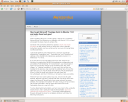It’s been quite a while since I last posted something on this blog, but two days ago I decided to install Ubuntu 7.10 (a.k.a. “Gutsy Gibbon”) on my laptop. And so I thought I might share my initial impressions.
The first thing I noticed is that the network manager (used for configuring wifi connections) no longer prompts the gnome-keyring-manager to ask me for a password every time I boot the computer. This is one of the biggest improvements, in my view.
Also when you surf to a flash site for the first time, you can now finally tell firefox to install the missing flash-plugin. You even get to choose between installing gnash or Adobe’s flash, which is very nice (but be sure to select Adobe’s flashplayer for now).
And I used the alternate installation CD for the installation, so I could configure the laptop hard drive to use encryption, which is yet another new feature in version 7.10. I was pleasantly surprised at how easy it was to do. At least now I don’t have to worry about people being able to get to my passwords, GnuPG secret keys, e-mail and other private data, if my laptop gets stolen or lost.
This is also the first Ubuntu system to finally correctly set the resolution to 1024×768 on my laptop. But although the new X configuration utility looks nice and simple, users who desire fine-grained control will still have to manually edit the xorg.conf file. Perhaps this utility will be improved in future releases.
And regrettably I have also discovered something to complain about. I began hearing the CPU fan come on constantly, which is very annoying, and so I ran the top command to find out the cause. Thus I noticed a process called “scrollkeeper-up” (=scrollkeeper-update) using over 80% of the available cpu cycles. After a little searching on google, I found a silly, but effective, hack to disable the scollkeeper-update program (it is not needed to run Ubuntu). I have even posted a question about this on the Ubuntu forum, but after 24 hours there are no replies (thread is located here).
For the time being I can ignore the problem. But of course when the scollkeeper program is included in a future software update, then I don’t know what is going to go wrong because of the quick and dirty fix I’m using.
Nevertheless, on the whole I’d say Ubuntu 7.10 is definitely a big improvement. (Well, so far anyway ;-)



 Posted by Menzonius
Posted by Menzonius 